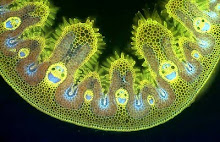Arisaema species are relatives of our native British wild arum or cuckoo pint (Arum maculatum), but are somewhat more elegant, with their curved, candy-striped spathe. They thrive in semi-shaded woodland conditions but I've often found that it's very easy to forget where you planted them and accidentally dig them up, so in recent years I've taken to planting them in pots, where their corms slowly increase by producing offsets. This species comes from North America, so should be very hardy - and I'm hoping that it will have survived the current unusually cold winter.
If you take a look here you can see some of the other species that are in cultivation - and also see why they are considered to be highly collectable plants. Unlike many aroids they don't have a strong smell - just a rather elegant floral architecture.





















